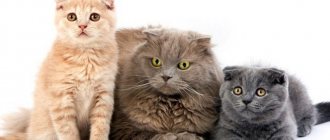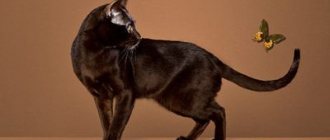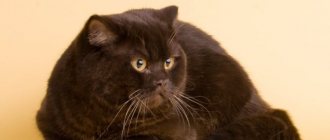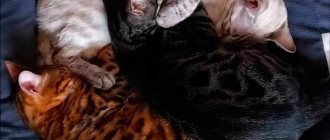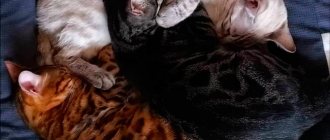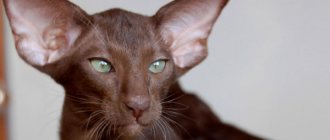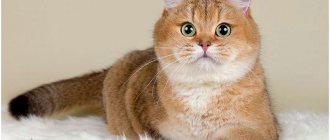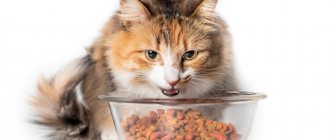Origin of the Burmese breed
The Burmese cat is considered one of the first in the world. The first mentions of similar cats can be found in images and poetry of the 13th century. The homeland is considered to be the south-eastern Asian country of Myanmar (formerly Burma). Cats were considered sacred animals and lived mainly in the houses of rulers.
Currently, the breed is divided into European and American types. Cats are distinguished by features that were formed in connection with the selection of animals on different continents.
American Burmese cat
The American Burmese begins its history when, in 1930, Dr. Joseph K. Thompson brought a cat named Wong-Mai to San Francisco. A Siamese cat of similar color was chosen for further breeding. The couple produced offspring. Kittens with the mother's gene continued to participate in breeding. Thanks to many years of hard work, Thompson was able to isolate the genes responsible for the necessary traits and fix them in the offspring. In 1938, the cat was presented at an exhibition, where it was officially recognized by the CFA organization as a separate breed.
Many became interested in the oriental beauty and the demand for kittens increased. The Siamese cat continued to participate in crossing, which is why the number of hybrid kittens increased. In view of this, in 1947 a decree was issued stating that a cat will be registered only if it meets all standards of appearance and has at least 3 pure generations in the family. In 1958, the development of a standard for the American Burmese breed began, which was recognized by all world organizations.
American Burmese cat
European Burmese cat
The development of the European type of Burmese began in England in 1949. The founder is considered to be Lilian Finance of Derby, who brought three Burmese kittens to the country.
At this time, a club of Burmese cat lovers was created and selection work began. It was also decided to use a Siamese cat for breeding. However, the European male turned out to be more refined and graceful, which outwardly influenced the development of the breed. Europeans, unlike Americans, sought to develop new colors. Thus, in 1955, the Burmese cat was introduced to Great Britain, which aroused delight and admiration due to its blue color.
The European Burmese cat received official recognition only in 1993, when it was decided to distinguish two types of the breed.
European Burmese cat
Burmilla breeding problems
Since the breed is included in the list of the ten rarest in the world, certain difficulties arise with breeding. They are associated with a long wait for a suitable partner for mating.
Breeding Burmilla is a difficult and troublesome task.
Those who decide to start breeding hybrid aristocratic cats will need a spacious room and patience, since the descendants of the Burmese, like other eastern breeds, are characterized by increased activity and a desire to meow incessantly and loudly during the mating period.
It is important to consider other points:
- estrus in cats of this breed begins at the age of 5–8 months;
- readiness for pregnancy and childbirth is formed only by 10–15 months;
- cats mature by 6–10 months and begin to mark their territory, engaging in similar boundary markings almost all year round;
- females show readiness for mating up to 10–15 times a year;
- sexually mature cats are ready to meet cats from 6–8 to 24 times a year;
- Pregnancy in cats lasts about 9 weeks, or 63–68 days.
Having chosen a partner for mating, you need to familiarize yourself with the pedigree of the animal and take an echogram of the internal organs. In this way, it will be possible to avoid health problems in the offspring.
Castration and sterilization
If a purebred animal is purchased not for breeding, but as a “couch” pet, it is better to castrate the pet as early as possible or use a more gentle procedure - sterilization. In the latter case, the cat’s genitals will not be removed, but only the tubules (or tubes, as in the case of females) will be tied up.
It is better to neuter your domestic Burmilla as early as possible.
If we talk about the age at which surgery can be performed, modern veterinarians recommend carrying out the procedure as early as possible - even before puberty. In cats, reproductive organs can be removed as early as 2 months of age, and in female cats - from three months. The previously held opinion about castration only after the onset of puberty has been refuted by scientists.
Modern laparoscopy methods make it possible to minimize the risks to the pet’s health and complications after surgery. So, for females, the process involves piercing the peritoneum on the side, and then removing the uterus and appendages through a small hole. Abdominal surgeries are currently performed extremely rarely.
After returning from the clinic, the animal must be looked after with special care for 24 hours, since during this time the pet’s body is recovering from anesthesia. You need to give your Burmilla plenty of water, feed him often and in small portions, and avoid falls and drafts.
Description of the Burmese cat
For the Burmese cat, the breed description for both types is similar. There are slight differences in appearance, which are shown in the table below.
In general, the Burmese has a strong build of medium size. A special feature is muscularity, which is clearly visible on the smooth body. A healthy cat should not show signs of obesity or thinness. The chest is wide. The wool is silky and has an unusual shimmer in the sunlight.
Eye color is allowed in the range from yellow to copper, saturation will be a plus. The ideal is an amber-honey shade. An animal will be disqualified for having a blue iris.
The average weight of cats is 3-4 kg with a height at the withers of about 30 cm. The weight of cats is approximately 5-6 kg, larger individuals may be found.
Due to its noticeable weight and average size, the Burmese kitty received the nickname “a brick wrapped in silk.”
CHOCOLATE TORTIE COLOR
We continue the story about Burmese colors. This time I want to show you a mysterious and unique color - CHOCOLATE TORTOIE. The pattern of this color is unique, it never repeats. There is a sign that tortoiseshell cats bring wealth and financial well-being to the home. You know, almost no Burmese breeder can do without a tortoiseshell color in his work. Why? Because it is tortoiseshell cats that often end up with the good type. They have a bright, rich eye color, an excellent, strong body. Tortoiseshell cats are always expressive and attract admiring glances.
European and American Burmese differences
| Part of the body | American Burmese | European Burmese |
| Body type | Aboriginal, stocky | Elegant, sophisticated |
| Head | Wedge-shaped with smooth features, rounded | Wedge-shaped with angular features, tapered |
| Eyes | Round shape | Lemon shape |
| Ears | Shorter, rounded ends | Longer, slightly forward |
| Limbs | Strong, not tall | Slender, elongated |
European Burmese
American Burmese
Colors of Burmese cats
Each type of breed has its own colors, which is an additional difference. In this case, there should not be any pattern on the fur coat.
The American Burmese has 4 colors:
- Sable or dark brown
- Chocolate (champagne)
- Blue
- Lilac (platinum)
The European Burmese has about 10 colors:
- Brown
- Chocolate
- Lilac
- Blue
- Red
- Cream
- Tortoiseshell: brown, chocolate, blue, lilac
Photos of Burmese (colors)
Photos of a Burmese cat will help you decide on the color.
The sable color of the Burmese is the most common and darkest acceptable: a black coat color disqualifies a cat from the breed.
Chocolate Burmese cat:
Lilac Burmese can have different shades and saturation (with the exception of cold gray), the color of light platinum with shades of pink is especially appreciated.
Burmese blue color:
A rare color of the Burmese breed is the red Burmese.
Cream Burmese color:
Tortoiseshell colors of the Burmese cat:
Lilac tortoiseshell (lilac with shades of cream)
Brown tortoiseshell (brown with shades of red)
Blue tortoiseshell
Chocolate tortoiseshell
SABLE COLOR
And of course, the SABLE color is also BROWN. The Sable color is a classic. He will always be in demand and popular. Buyers want this color more often than others. What is his secret? To be honest, I think it's all about the photogenic nature of sable cats. The dark fur, like a diamond, glitters and shimmers in the sun and in the light of the spotlights. Definitely, in the photo, no color compares to sable, a favorite of photo shoots. And of course, honey eyes are very bright and look great against brown. Sable comes in different shades. In Australian and New Zealand lines it often has a warm, cognac tint (my favorite variation of this color). Scandinavian lines are darker and colder. With age, these cats become almost black. Breeders combine these lines and get a whole palette of sable colors. All you have to do is figure out what color you want? And here I will allow myself to give advice) Do not judge a kitten only by the photo. Come and see the kids live. Then your choice will be clear and unmistakable. In 70% of cases, buyers, after seeing the kids, changed their initial opinion. I wish you good luck in choosing your Burmese!
Character and habits
The breed standard includes not only the appearance, but also the predominant features of the Burmese character. Thanks to its cheerfulness, tenderness and love of love, the Burmese cat has become popular and in demand.
The Burmese cat breed is very talkative: it will meet you after work and tell you everything that happened to it that day. Curious and smart. He always tries to be closer to his owner, whether it’s sitting on the couch or doing household chores. Activity is an integral part of the Burmese cat's character, which manifests itself even in old age. Burmese do not like loneliness and make excellent company for children.
Due to its special character traits, the Burmese cat is sometimes called a dog. They are trainable and you can learn a couple of commands. The second feature of the Burmese representatives is affection, which manifests itself not to the place of residence, but specifically to the person.
Price
Prices for kittens depend on the following factors:
- presence of pedigree;
- gender;
- market situation in the country.
In foreign countries prices start from 500 euros. In Russia, a child can be bought for 15-50 thousand rubles, which in foreign currency is 220-730 euros.
Thus, the American Burmese is an unpretentious cat with an attractive appearance, a golden character, a magnetic look and soft, silky fur. Representatives of this ancient breed are smart, quick-witted, and amenable to training. Until adulthood, they remain mobile and maintain a tender attachment to their owner. They do not require special care. Suitable for people suffering from allergies.
Care and maintenance
Caring for a Burmese cat at home will not be a hassle. Once a week, it is enough to arm yourself with a special rubber comb and comb your pet’s fur. The Burmese also does not need frequent water treatments. They bathe mainly before a show or once every 3-4 months. Burmese cats are very clean: in order to avoid surprises, clean your pet’s bowls and litter tray in a timely manner.
Eyes and ears need timely care. The sore spot for all Easterners is the gums, so you need to clean them with a special paste at least once a week. The claws are trimmed about 1-2 mm per month, but mostly they set up a scratching post and forget about this need.
The Burmese cat breed can freeze due to the fact that it has no undercoat. Avoid drafts and ideally place a bed or house in a secluded place. Your pet will be happy to walk outside in a harness if you teach the kitten to do so from childhood.
How to choose a kitten
Burmese kittens are born small in appearance and parameters and look small at 3 months. At first, the babies are all white and the main color will develop when they are one year old.
When choosing, they evaluate the appearance of the kitten; it should not be thin, but active. Examine the eyes, ears, anus. A healthy baby does not have gray-yellow discharge, and the stomach is not swollen and soft.
If possible, examine the cat's mother and the family's habitat.
Before selling kittens, breeders vaccinate kittens according to age, wean them from mother's milk and transfer them to independent feeding.
In the nursery, a complete package of documents with a veterinary passport and a registered pedigree will be prepared for a Burmese kitten. When studying the composition of ancestors, they make sure that there are no hereditary diseases in the line.
Important! It is recommended to buy an elite breed of Burmese kitten from licensed nurseries, which guarantee that the baby will not have hereditary diseases.
Kolenie
The basic nutrition of a Burmese cat is the same as that of all felines and differs at different periods of life (kitten, adult cat, sterilization or castration, pregnancy and the postpartum period).
Decide what food you want to use and do not mix them: will it be natural products or specialized food. Among industrial feeds, give preference to high-quality feeds with a high protein content (see instructions). A natural diet should consist of 80% lean meat, as well as cereals, vegetables and herbs.
For the health of Burmese pets, do not feed them your own food from the table. Cats are prohibited from giving salted, peppered, smoked, etc. products.
Health and breed diseases
Each breed has its own “weak points” and Burmese kittens are no exception:
- Gingivitis. Prevention includes weekly teeth brushing and hard treats.
- Breathing problems. They may occur due to the structural features of the cat’s nasal cavity.
- Tearing. Use eye drops and rub your pet's eyes.
- Potassium deficiency (hypokalemia). Signs include fatigue, apathy and drowsiness. If treatment is delayed, paralysis may occur.
- Gangliosidosis (GM2). It is inherited in Burmese kittens and cannot be treated. The first signs in the form of impaired coordination and tremors in the body or limbs appear at the age of 1-5 months. Death occurs at 8-10 months. The defect can be identified by doing a DNA test.
Remember about vaccination. The first manipulations are carried out for up to 3 months and then repeated annually.
The lifespan of a Burmese cat is about 12-15 years.
Reviews from Burmese owners
Svetlana I love my Burmka madly. An affectionate and sociable girl. I like that she responds to her name. Everything is fine, but sometimes I want to make the regulator for her talkativeness smaller.
Ksenia We approached the choice of a pet very responsibly, because we had a bad experience with another breed. The whole family read the reviews, went to exhibitions and finally settled on the handsome Burmese. We are very pleased with his character: affectionate, flexible, friendly, the life of the party. The children are delighted with his restlessness. In general, everyone is delighted.
Olga “Wow” is the first thing all our friends say when they come to our house. And this is a reaction not to the new renovation, but to our Burmese resident. What is surprising is that the cat calmly goes to new people and even caresses. We did not observe any problems with the tray. No special care required. The character is affectionate and loves the two of us with my husband. We recommend this breed to everyone.
Buy a Burmese cat
To purchase a Burmese cat, we recommend contacting a club or a professional breeder. It is in such organizations that you can purchase a purebred, and most importantly, healthy kitten. Do not rush to transport your pet to a new home: wait until he is 3-4 months old. Before this age, kittens are usually reserved by signing a contract and paying a deposit.
How to choose a kitten
Find out what conditions kittens live in and how they behave with people. Animals are not allowed to stay in cages. Healthy kittens are active and mobile, easily make contact, and in no case show aggression or fear. Having decided on your future kitten, carefully look at the eyes, ears and under the tail: there should be no discharge in these places. Talk to the breeder about the pedigree, ask about health in the family. Be sure to see if the kitten meets the standards of the Burmese breed.
Burmese cat price
First, decide what type of Burmese kitten and gender you want. Oddly enough, boys usually cost more than girls. One of the cost components is color.
The most important thing on which the price of a Burmese depends is the purpose of the acquisition. A purebred kitten as a pet (for sterilization/castration) will cost around $150-250 (10,000-16,000 rubles). A Burmese kitten for breeding or exhibitions is sold at a price of $350 (from 25,000 rubles). In this case, the price is additionally influenced by the pedigree and received medals of the parents.
A little history
But there is another version according to which amazing animals came to Europe from the USA.
The independent Burmese breed was formed in America through the efforts of the doctor Joseph Thompson.
